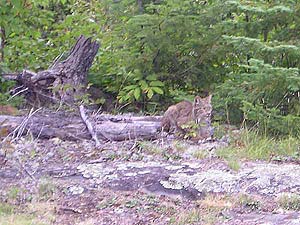|
Audio
Photos
More from MPR
Resources
|
Duluth, Minn. — Six years ago, there was little evidence that Minnesota even had a population of Canada lynx. The 20 to 30 pound cats with distinctive tufted ears had rarely been seen in a decade. Now, researchers say, there may be as many as 400 lynx apparently thriving in Northeast Minnesota.
Researcher Ron Moen has been putting global positioning collars on lynx.
"You know, we actually have over 10,000 locations of where lynx have been, within GPS precision," Moen says. "And that's more than, I think, anyone else in the world has, to tell you the truth, because this study began just when collars could be small enough to be worn by lynx and have a GPS unit inside of it".
Canada lynx are listed as a threatened species, under the Endangered Species Act. An environmental group lawsuit forced the U.S. Fish and Wildlife Service to declare where habitat is critical for lynx to survive. They've isolated regions in Maine, Idaho, Northern Montana and Northeastern Minnesota. Critical habitat is hard to define, and is decided on a case by case basis within a region.
The Fish and Wildlife service is proposing the designation for the Arrowhead, east of Highway 53 but outside the borders of the Superior National Forest. Lynx protections are already in place in the Superior National Forest. The U.S. Fish and Wildlife Service's Phil Delphey says a critical habitat designation brings some restrictions.
"Critical habitat only has a regulatory - a legal or regulatory impact on the actions of federal agencies," Delphey says. "They cannot destroy or adversely modify critical habitat."
The designation could restrict a project if it destroys habitat favored by snowshoe hare - the lynx' favorite food. But Delphey says there's a fairly high bar.
"It wouldn't be anything minor, but it would be something that would have a very significant effect on the ability of the critical habitat to conserve the species," says Delphey.
But in Cook County, commissioners worry the designation comes with costs. It can force a lynx study before construction of new roads or trails; driveways or housing developments - as long as federal property, permits, or money is involved. County Commissioner Jim Johnson says, with most of Cook County under Federal ownership, it's not unusual a project would require access across federal land.
"It may not stop a project, but it would be one more hurdle to jump through," says Johnson. "And all of those things cost counties money, they cost states money, they cost everybody money when they do it."
And Johnson says the critical habitat designation can give opponents another legal tool to block regional development.
Meanwhile, conservation groups are calling for new restrictions on fur trapping to protect lynx. Linda Hatfield, with the group known as HOWL, (Help Our Wolves Live) says lynx aren't the target but some are still trapped and killed.
Hatfield has asked for a total ban on trapping in both the Superior and Chippewa National Forests.
"When endangered and threatened species are getting caught, and dying in snares and traps, then HOWL wants to take a really good look at this," Hatfield says.
The Forest Service hasn't yet responded to HOWL's request.
Meanwhile, a coalition of environmental groups has asked the state Department of Natural Resources to change trapping rules to minimize the risk of catching lynx.
Researcher Ron Moen, with the Natural Resources Research Institute in Duluth, says it's one step that would help reduce how many lynx are accidentally killed, but it's unclear how much even a ban on trapping would really help the lynx population.
"Whether or not it would have a significant difference, I don't think our sample size is large enough to say," Moen says.
DNR Wildlife Program Manager Mike Don Carlos says a response is still being prepared to that request.
A comment period on the critical habitat designation is open until February 7th, but it's expected to be extended until April. A study on the economic effects of the designation is due in March, and the final rule is expected in November.






